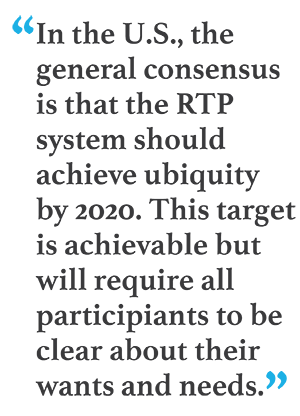
A strong payment infrastructure provides essential plumbing tocarry the financial flows of businesses. For most companies,payments move via an orderly process that has followed the sameslow, steady schedule for decades. But today, for the first time in40 years, corporate treasury departments have a new option:real-time payments (RTP). Companies can now add a new pipe totheir plumbing to accommodate funds transfers that move atunprecedented speeds.
|The idea sounds compelling, but changing a core corporate systemthat's already working well can be frightening. At first sight, RTPmay seem like an intimidating, costly investment that offers onlyamorphous benefits. Cost-conscious corporate treasury departmentsrarely set aside large budgets for innovation in accounts payable(A/P) and accounts receivable (A/R) systems.
|The most successful RTP adoptions are those that are carefullydesigned to fit an organization's unique and specific needs,ultimately making their treasury teams integral to the company'sstrong relationships with clients and business partners. At the endof the day, a successful payment ecosystem is one that mixes andmatches payment methods so that each payment utilizes thesettlement method that is best for both the buyer and theseller.
||
Improvements to Cash Flows
Through real-time payments, corporate treasury departments canmake disbursements or payments to customers and business partnersaround the clock, sending requests and receiving instantconfirmations of the transaction. While the name “RTP” focusesattention on the speed of funds settlement, real-time payments'larger benefit can be found in the information that travels witheach payment.
|RTP enables senders and receivers to have more detailedconversations about each payment. That's because bothcounterparties to a transaction have an array of standardizedmessage types at their disposal. These are built into the RTPmessaging standard to handle common scenarios in the lifecycle of atransaction. They facilitate communication when a transactioncompletes successfully, as well as enabling the counterparties tocommunicate about exceptions. For example, a company responding toa payment request from a supplier can either accept the request inits entirety or select only certain line items that it agrees topay for and immediately communicate that information to thesupplier. It can also indicate that an invoice number is not found,or that an invoice amount is not correct. A recipient of a paymentcan indicate that the amount received is incorrect and requestreconciliation.
|Because these exchanges are happening directly within thepayment system, the communications do not require individuals toswitch into an email system to compose a free-form email orinterrupt their workflow with a phone call or fax. RTP's messagingand automation capabilities take ad hoc, unstructured follow-up outof the equation.
| Instant communications amongcorporate counterparties around requests for payment, approvals orrejections, and payment confirmations produce value up and down thecompany's customer and supplier networks. Both the speed andgranularity of communications in RTP messaging can accelerateresolution of exceptions. Moreover, the detailed payment messagessimplify account reconciliation and help companies develop anaccurate snapshot of their current and upcoming cash positions.When treasuries trade float for visibility, they enable business tobe conducted with far more certainty.
Instant communications amongcorporate counterparties around requests for payment, approvals orrejections, and payment confirmations produce value up and down thecompany's customer and supplier networks. Both the speed andgranularity of communications in RTP messaging can accelerateresolution of exceptions. Moreover, the detailed payment messagessimplify account reconciliation and help companies develop anaccurate snapshot of their current and upcoming cash positions.When treasuries trade float for visibility, they enable business tobe conducted with far more certainty.
In fact, as the settlement process comes close to real-time, thepayments themselves become a conversation. Suddenly, corporatetreasury departments are provided with the rare chance to interactwith customers, wholesalers, suppliers, vendors, service providers,and other trading partners, 24×7. The consumer-services sector is aprime example of an industry that stands to gain from RTP in thisway. Consumers are already used to interacting with businesses atall hours of the day and night. With RTP, an insurance company maybe able to provide more timely support, sending disaster reliefdisbursements on weekends if that's when their clients most needassistance. Likewise, a utilities company can process customers'payments after regular office hours, when customers feel mostcomfortable taking care of personal matters.
||
Where RTP Fits in the Payment Landscape
Obviously, a company can achieve these benefits only after bothit and its trading partners adopt RTP technologies. And large-scaleevolution of the U.S. payment infrastructure cannot be achievedthrough participation of a few. Rather, it requires banks andbusinesses to work together to make real-time payments ubiquitousthroughout the financial services industry. Only at the point ofwidespread uptake of real-time payments, through industrywidecollaboration, will this innovation be a success.
|Although RTP has the potential to bring revolutionary change, weexpect the Automated Clearing House (ACH) payment network to alsocontinue developing. When RTP is ubiquitous, it will overcome thelimitations of ACH cut-off times; companies will no longer have towait for their banks to accumulate transactions received throughoutthe day, to process them all simultaneously in one batch. However,same-day ACH or next-day ACH may still be the best payment optionfor many transactions. ACH still offers a decided cost advantageover RTP in use cases that meet four criteria: First, the payer andpayee are well-known to each other; second, the payment and amountare known in advance and can be scheduled; third, the payment isrecurring; and fourth, there is little likelihood that the paymentmight need to be revoked. In these scenarios, ACH remains a provensolution. It is unreasonable to imagine that transactions such aspayments to salaried employees or long-standing suppliers wouldmigrate to RTP.
|Nevertheless, the advantages of RTP may trump cost concerns insituations where a company needs the ability to initiate requests24×7. RTP also has the edge when the finality of the paymentmatters—such as when the company needs to request funds from adelinquent customer in order to restore service, or request paymentfrom a new customer who might revoke payment after the goods havebeen shipped.
- Related: Real-Time Payments Have Arrived
Eventually, companies deciding how to allocate payments amongACH, RTP, and other payment methods will have to identify the mosteffective approach for each type of transaction that they make.Then they will have to work with their counterparties to define theparameters for each payment method. The general rule of thumb isthe more that speed and finality matter, the greater the businesscase for RTP.
|Having another option in the corporate payment portfoliofacilitates a new way of interacting with clients and customers.Businesses can meet customers' needs more precisely by leveragingthe best available payment option. That is why we foresee the ACHnetwork, the incumbent payment system of choice, living a long,happy life alongside RTP.
||
Prepare Now for RTP
RTP has the potential to be transformative for corporates bycreating better opportunities for client interaction, but theadoption of RTP is a step-by-step process that treasury departmentsand banks must undertake together. This process must always beginwith a deep understanding of the unique needs and characteristicsof each company's payment system. Businesses consideringimplementing RTP need to begin by considering what their currentsystems look like, what their needs are, and which payment methodscan best accommodate each of those needs. RTP is one of severalpayment methods that will all need to be woven into consolidatedA/P and A/R systems.
|Some companies see these discussions as an opportunity tore-evaluate the entirety of their end-to-end systems. They investin technology upgrades in order to fully integrate RTP into theirERP system and develop back-end functionality to support the richdata around their transactions. More often, they look for the mostcost-efficient way to integrate RTP into their existing systems andprocesses, because a typical treasury department does not have theresources or budget to undertake a fundamental transformation fromthe ground up.
|One of the largest shifts with RTP is the movement from a worldof batch processing to a world of regular flow of messaging overapplication programming interfaces, or APIs.Many older treasury management systems are designed on the model ofperiodic transmittal of information in batches, and so are the ERPand other business systems with which they exchange information.Those systems will continue to exist in parallel, just as RTP willexist in parallel with other payment rails. This coexistencepresents numerous technical design challenges that require closepartnership with IT to resolve.
|In addition, moving from batch mode to batch-plus-API moderequires changes to underlying business processes and employeebehaviors. The path to adoption must include robust and intentionalchange management efforts. It also likely calls for re-engineeringmany processes such as order-to-cash and supply chain processesthat historically resulted only in periodic batches of transactionsat a few points in the business day. Customer relationshipmanagement (CRM), demand chain, and fulfillment might also benefitfrom RTP-related process improvements.
|Companies with international operations may have a differentview of the path to adoption, if they are operating in marketswhere instant payments have been in place longer. They can alreadylook to best practices and existing experience working with localcorrespondent banking partners as a way to leverage both technicaland operational expertise. For the time being, they will have toleverage each of these networks and systems individually and workwith their bank partners to find the best solutions to get paymentsinto local clearing channels, but that experience can offerrepeatable models for RTP in the United States.
|Multinationals also provide the footprint for what will be thenext stage of evolution for the industries and payment networksaround the world: global real-time payments. As global standardsemerge and networks begin to fit together, banks will increasinglyoffer more cross-border payment solutions to match their corporateclients' geographical footprints.
|In the U.S., the general consensus is that the RTP paymentsystem should achieve ubiquity by 2020. Although ambitious, thistarget is achievable—but it will require all participants to beclear about their wants and needs. The payment network is only aspowerful as the combined experiences of the banks and corporatetreasury departments that are using it, and that are providing oneanother with constant guidance and feedback. The more collaborationthere is, the better the payment ecosystem will work, bothdomestically and globally.
|For businesses, the transition to using RTP is not easy. Butwhen RTP reaches critical mass within the business community, weexpect it to bring substantial improvements to treasury andpayments systems. We envision a future where corporate treasurydepartments are leading the conversation on customer interactionand where consumer insights about preferences, satisfaction,profitability, and payment performance are mined from the newlytapped streams of payments information. With today's thirst forinnovation and growth, we believe this journey is hugely promising,bringing this area of financial services back to the future.
| Michael Bellacosa isa managing director at BNY Mellon and head of the bank's GlobalPayments Product Management Group. He is responsible for globalwire clearing, multicurrency, FX, ACH, and real-time paymentservices. He is based in New York and has over 20 years of paymentexperience in product and operations management.
Michael Bellacosa isa managing director at BNY Mellon and head of the bank's GlobalPayments Product Management Group. He is responsible for globalwire clearing, multicurrency, FX, ACH, and real-time paymentservices. He is based in New York and has over 20 years of paymentexperience in product and operations management.
 Carl Slabicki is adirector and product line manager at BNY Mellon for immediatepayments. In his current role, Slabicki is responsible for strategyand development of new faster payment solutions such as TheClearing House's real-time payments and Tokenized Payments® nowavailable with Zelle®.
Carl Slabicki is adirector and product line manager at BNY Mellon for immediatepayments. In his current role, Slabicki is responsible for strategyand development of new faster payment solutions such as TheClearing House's real-time payments and Tokenized Payments® nowavailable with Zelle®.
BNY Mellon originated the first transaction to go out overthe RTP network on November 13, 2017.
Complete your profile to continue reading and get FREE access to Treasury & Risk, part of your ALM digital membership.
Your access to unlimited Treasury & Risk content isn’t changing.
Once you are an ALM digital member, you’ll receive:
- Critical Treasury & Risk information including in-depth analysis of treasury and finance best practices, case studies with corporate innovators, informative newsletters, educational webcasts and videos, and resources from industry leaders.
- Exclusive discounts on ALM and Treasury & Risk events.
- Access to other award-winning ALM websites including PropertyCasualty360.com and Law.com.
*May exclude premium content
Already have an account? Sign In
© 2024 ALM Global, LLC, All Rights Reserved. Request academic re-use from www.copyright.com. All other uses, submit a request to [email protected]. For more information visit Asset & Logo Licensing.






